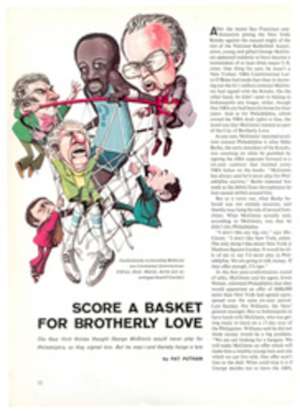
EVEN BEAUTIFUL BATHERS LOOKED LIKE FLOTSAM IN CONEY'S "GOOD" OLD DAYS
The moonlight gleamed on the rippling sea.
And the lamps lit the foamy strand,
While voices blended in merry glee,
With the sweet music of the band.
That night the time seemed fleeting,
And, oh, my heart was beating!
For that was our first meeting,
At Gay Manhattan Beach!
Songwriter George Vickers' 1896 tribute to Manhattan Beach, which adjoins that early Disneyland, Coney Island, evokes an image of polite, simple and comfortable days unmarred by the crass vulgarities of our own time. How pleasant it must have been before pollution, overpopulation and neglect converted white sand and clear water to mottled minefields of thrown-away throwaways and putrid petrochemicals.
Unless, of course, the good old days at Coney Island and adjacent beaches never really existed. Is that possible?
It is. For one thing, even then there was pollution. Three miles offshore a garbage buoy was anchored. But occasionally a scow pilot would shorten his trip considerably. The results of one abbreviated journey became apparent on an August Sunday in 1886. That day a huge island of decaying vegetation appeared 20 yards offshore. "There were layers of stuff, like a big raft," a reporter wrote. "The substratum seemed to be of straw, hay, and weeds. This was cemented with mud, ashes, and sewage.... It carried a miscellaneous cargo...cut melons, decayed fruit, grease-coated barrel staves, old bottles and an assortment of cats and dogs in various post-mortem stages.... The breakers came up and lapped this mass, but could not get over, under, or around it. They served, however, to push it up on the beach...."
Of course, this wasn't an everyday occurrence at Coney Island. What was were the discomforts of the transportation system, which crushed visitors together on steamers and in railroad cars and frequently left hundreds more stranded at dockside.
Those who made it to Coney had to contend with the basic problem of the swimwear of the 1870s and '80s. Anxiety attacks among women of all ages and shapes must have been common when they faced the prospect of donning the traditional loose flannel bathing gowns that apparently were designed to make the wearers look as ugly as possible.
"In this respect the flannel gown was a complete success, since had Venus herself risen from the ocean arrayed in a bathing gown, she would have been mistaken for the grandmother of the gods," wrote The New York Times. "Nevertheless, it had one conspicuous facet. When in the water it had a way of expanding and floating to the surface, whereby the wearer was made to resemble a blue cotton umbrella.... For this reason it gradually fell into disrepute and is now met only on remote New England beaches, where it is still worn by angular schoolteachers who desire to strike terror into casual sharks."
The one-piece gown was succeeded by a blouse-and-trousers outfit, of which the Times wrote: "At rare intervals beauty actually triumphed over the bathing-dress and at every sea-beach legends yet survive of some miraculous woman who was beautiful in spite of flannel blouse and trousers." Less fortunate women had someone meet them at water's edge with a large shawl.
As for the other attractions at Coney Island in those days, today most would be considered tame at best and rip-offs at worst. One of the most sensational was the "colossal elephant," which was completed in 1885 and heralded by its owner as the eighth wonder of the world. Not everyone was that impressed by the 100,000-ton, 122-foot-tall monstrosity that housed a quasi-scientific "museum of natural history" in a gallery called the Stomach Room. "The Colossal Elephant at Coney Island has not been favored with much serious public attention," the Scientific American commented, "owing to the fact principally that it is not an artistic work, and secondly, because it is the project and property of a stock company, whose unexalted aim was to rear a structure that would serve, not so much to elevate the public mind artistically, nor to stand as a monument to some of our noted forefathers, but rather to abstract the unwary dime from the inquisitive sight-seer."
More successful were the grand pyrotechnical performances. A typical show was entitled "The Siege of Sebastopol" and pitted the "allies" (French and British) against the "enemy" (Russians). With a cast of 500, the production was carried off with a maximum of volume as the Russians were defeated each night beginning at 7:45. During the intermission, while the cavalry and infantry reloaded their weapons with fresh fireworks, customers were treated to "class" entertainment such as a cutlass drill by 20 sailors from the Brooklyn Navy Yard.
During the 1880s Coney Island was essentially "owned" by John Y. McKane. As police chief of Gravesend, the nearest municipality, McKane was the voice of authority; as health commissioner, McKane could make important decisions regarding sanitation and zoning; as chairman of the Gravesend Town Board, McKane ordered his decisions carried out; as chief contractor, he carried them out; as town auditor, he approved his own bills; and as chairman pro tern of the Kings County Board of Supervisors, he saw to it that he was paid on time.
This concentration of power often hit visitors to Coney Island where it hurt, because McKane needed money to finance his projects. Every so often he would swoop down on the resort, round up whomever he pleased and fine them whatever sum he deemed appropriate. He made just such a raid on July 12, 1885, arresting 36 men and women who were loitering less than 10 feet apart, plus one man sleeping on the beach.
McKane justified his fines on moral bases. "This is a playground, and I mean it to be a harmless one," he said. "The ocean's coming up and we'll all be swamped soon, but we'll go down pure or know the reason why."
In Coney Island John McKane's word was law. That may have been the reason the resort was struck by a giant tidal wave on Sept. 8, 1889. It drenched more than 2,000 people, destroyed the Manhattan Beach amphitheater and washed away the walks in front of the posh Oriental Hotel. In the process, it gave another display of why the good old days may not have been so grand.

